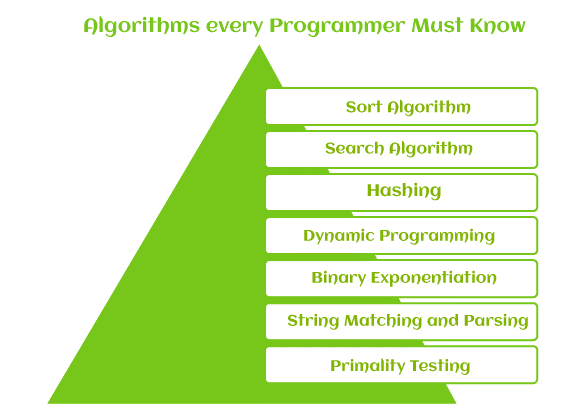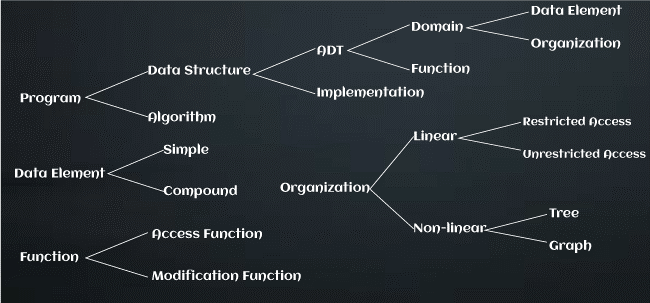Data Structures Algorithms
What is an Algorithm?
An algorithm is a sequence of steps used to complete a job or get a desired result. It is similar to programming building elements that let cell phones, computers, or websites to run smoothly and make judgments. Each line of code generated by a programmer is a collection of algorithms that determine what to perform. Algorithms are well-defined techniques that assist computers in problem solving.
Let's look at GPS as an example. When you search for a destination, GPS utilises an algorithm to search for many accessible routes. GPS also uses a different algorithm to check current traffic, and based on the collective information, it delivers the best possible route for you. All of these techniques are included into the GPS software. As a result, if there is a mistake in the GPS code, it will not operate properly, offering inaccurate directions. Algorithms are used by computers to perform calculations considerably faster than humans.

How is Data Structure and Algorithm related?
Data structures and algorithms are inextricably linked and mutually beneficial. An algorithm applies to a certain data structure, and employing the correct data structure significantly improves an algorithm's performance. As a result, we can't separate data structures and algorithms.
The primary types of algorithms in respect to data structures are as follows:
- Search– This method aids in the discovery of an object within a data structure.
- Insert– This algorithm may be used to insert an item into a data structure.
- Sort– This algorithm aids in the arrangement of objects in a given order.
- Update– The update method may be used to update an existing item in a data structure.
- Delete– The delete algorithm may be used to remove an existing item from a data structure.

Why learn Data Structure and Algorithm?
Data structures and algorithms are the most important topics for programmers and Computer Science graduates to understand in order to acquire a job and do well in it. Here are a few compelling reasons to study data structures and algorithms:
- The essential basis of producing good code is a thorough understanding of data structures in conjunction with algorithms. It lowers coding costs while improving data accuracy, which is the ultimate aim of enterprises.
- To earn salary comparable to those of Amazon and Google developers, you must increase your problem-solving skills by learning data structures and algorithms.
- It is critical to master these ideas if you wish to produce bug-free output when coding.
- Learning data structures and algorithms may also help you comprehend new frameworks like Angular, React, Vue, Spring MVC, and others.
- When you are exposed to a variety of problem-solving strategies, it makes it easier to tackle the next difficult challenge.
- Data structure and algorithm experts can readily accomplish jobs involving data processing, automated reasoning, or computations.
- Data structure and algorithm are important for developers since they demonstrate their problem-solving talents to prospective employers. As a result, the chances of receiving the job are increased.
The choice of data structure method can be the difference between a programme running in a few seconds and a programme running for several days. You can only make an excellent decision if you have that degree of advanced knowledge of data structures and algorithms.
Algorithms and data structures Learning Topics for Competitive Programming
Although data structure and algorithm are large subjects in their own right, there are a few crucial areas you should be familiar with before attending an interview:
- Algorithms and Data Structures' Role in Problem Solving
- Data Structure Varieties
- Identifying Algorithm Design Techniques
- Using the Bubble Sort Algorithm to Sort Data
- Linear Search is being performed.
- Using the Selection Sort Algorithm to Sort Data
- Binary Search is being implemented.
- Sorting data using the Shell Sort Algorithm.
- Allocation of Dynamic Memory
- Adding a Node to a Linked List.
- navigating a doubly-linked list
- Putting a Circular Linked List in Place.
- Sorting data using the Merge Sort Algorithm.
- Using Linked Lists to Add Polynomials
- Using an Array to implement a Stack.
- Using a Linked List to implement a Stack.
- Identifying various Queue procedures.
- Using an Array to implement a Queue.
- Hashing
- Data Storage in a Tree
- Creating a Binary Search Tree.
- Creating and indexing a Threaded Binary Tree.
- Tree with a balanced height.
- Graph Data Storage in a Graph
Conclusion
As long as programming and coding are alive and well, technology will only get better at what it does. As a result, the relevance of data structures and algorithms in the working of technologies, navigating what they do and how they do it, will stay constant.